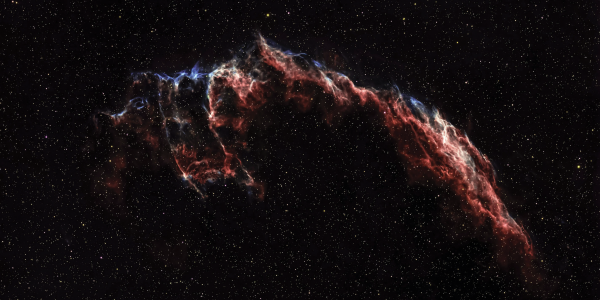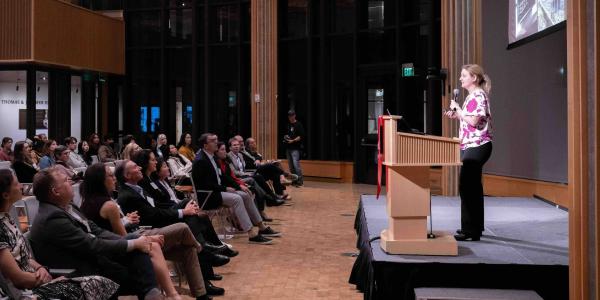A half-century ago, aviation pioneer and former WashU board chair James S. McDonnell announced a $4 million gift (worth nearly $26 million today) to create the McDonnell Center for the Space Sciences (MCSS). Since then, his mission to establish the university and St. Louis as a hub for space exploration and research has been fulfilled many times over. The center now supports the work of over 100 researchers, including more than 40 WashU faculty members.
Whether they’re using telescopes to peer across the galaxy or spectrometers to get an up-close view of materials from other worlds, the center’s researchers have significantly expanded our understanding of the universe and our place in it.
To celebrate this milestone, we’re highlighting some of the missions and discoveries that put MCSS at the center of space research.

1969
Robert M. Walker, the center’s inaugural director, and his research team receive one of the first batches of lunar samples from the Apollo 11 mission. Using techniques invented by Walker, the team studied the samples for signs of exposure to cosmic rays and other types of radiation. The work provided new insights into the history of the solar system.

1976
Viking 1 lands on Mars, a breakthrough for solar system exploration and a pivotal moment in the early years of MCSS. Raymond E. Arvidson, then an assistant professor and now the James S. McDonnell Distinguished University Professor Emeritus, was on (and eventually led) the imaging team that captured the first close-up views of the surface of the red planet. The mission transformed our knowledge of Mars and set the stage for future missions, including the Mars Exploration Rovers Spirit and Opportunity in 2004, for which Arvidson was deputy principal investigator.

1982
Robert M. Walker and members of his laboratory revolutionize the study of space materials with the help of an ion microprobe, an instrument that measures isotopes in microscopic samples from meteorites and the Moon. Walker and his team would go on to identify and characterize stardust in meteorites, opening a window into the evolution of stars that predate the Sun and the origin of materials of our solar system.

WashU
1989
NASA establishes its Planetary Data System and places WashU — under the direction of Professor Ray Arvidson — in charge of the Geosciences Node, making the university a repository of data from Mars, the Moon, and other solid bodies. Now directed by Associate Professor Paul Byrne, the Geosciences Node remains an invaluable resource for planetary researchers worldwide.

2000
The first NanoSIMS is installed at WashU. This first-of-its-kind instrument made it possible to study the origin and evolution of the solar system through analyses of extraterrestrial materials, including rocks and dust from asteroids and comets, circumstellar and interstellar dust particles, and samples of the solar wind.

2007
Thanks in large part to the vision and planning of Professor James H. Buckley, along with the work of a team of scientists and engineers at WashU, construction is completed on VERITAS, a high-energy gamma-ray observatory in Arizona. The observatory continues to advance our understanding of the universe, including the forces around black holes and the existence of dark matter.

2012
SuperTIGER, a balloon-borne instrument designed to detect elements heavier than iron in high-energy cosmic rays, launches from Antarctica under the leadership of Research Professor W. Robert Binns. Brian Rauch, research associate professor of physics, leads the SuperTIGER-II missions in 2019 and 2020, furthering our knowledge of the origins of cosmic rays from beyond our solar system.

Laboratory/ Southwest Research Institute
2015
NASA’s New Horizons spacecraft, launched in 2006, completes a fly-by of Pluto and its system of satellites, marking the first close-up exploration of the dwarf planet. William B. McKinnon, the Clark Way Harrison Distinguished Professor in Arts & Sciences, was a co-investigator and one of the original scientists to conceive the mission.

2024
XL-Calibur, a telescope carried by a stadium-size scientific balloon, launches from the Esrange Space Center in Sweden. XL-Calibur soared to an altitude of 130,000 ft and traversed the Atlantic ocean to northern Canada, where the mission ended. The data will be used to search for energy streaming from a black hole. Henric Krawczynski, the Wilfred R. and Ann Lee Konneker Distinguished Professor in Physics and principal investigator of the mission, will use the data to track the swirl of matter as it gets pulled into the massive object, revealing fundamental properties of the black hole, including its spin.

2024
NASA’s Europa Clipper launches to explore an icy ocean moon of Jupiter that could be the most promising spot in the solar system for life beyond Earth. William B. McKinnon, a member of the mission’s science team, played a pivotal role in planning the scientific observations that will be made of the moon and its ocean, insights critical for exploring the likelihood of life beneath the ice.
This story appeared in the Spring 2025 issue of Ampersand magazine. See more stories from the magazine and browse our archives.





